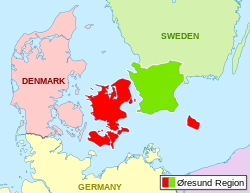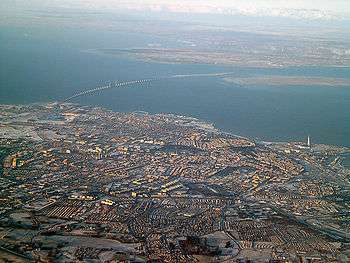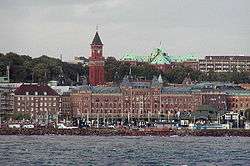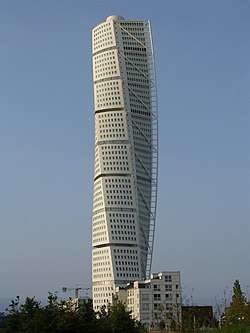Øresund Region
The Øresund Region (Danish: Øresundsregionen [ˈøːɐsɔnsʁekiˌoˀnn̩]; Swedish: Öresundsregionen [œːrɛˈsɵ̂nːdsrɛɡɪˌuːnɛn]), also known as Greater Copenhagen for marketing purposes,[1] is a metropolitan region that comprises eastern Denmark and Skåne in southern Sweden. Centred around the Øresund strait and the two cities which lie on either side, Copenhagen in Denmark and Malmö in Sweden, the region is connected by the Øresund Bridge, which spans the strait at its southern end, and the HH Ferry route between Helsingør, Denmark, and Helsingborg, Sweden, at the narrowest point of the strait.





The Capital Region of Denmark and Region Zealand constitute the Danish side, while Scania constitutes the Swedish side.[2] The region has a population of 4,002,372 (2018) and a population density of 192/km2 (500/sq mi).[2]
Since the Treaty of Roskilde of 1658, Scania (Swedish: Skåne) has been subordinate to the King of Sweden, except during the Scanian War (1676–79) and briefly in 1710, but it only became a province of Sweden under the Treaty of Stockholm 1720 (dated 3 July 1720).[3] From 800 to 1658, Greater Copenhagen was united under the flag of Denmark, although in the early years Denmark sometimes had several local kings. In recent years, part of the population has stressed Scania's regional identity again.[4]
The Øresund Region consists of both rural and urban areas. There are two metropolitan areas within the region, Copenhagen metropolitan area and Metropolitan Malmö.[5] Areas on the periphery of the region have a relatively low population density, whereas the two metropolitan areas of Copenhagen and Malmö are two of the most densely populated in Scandinavia. Helsingborg also forms an important urban hub on the Swedish side.
Cross-border activity
The Øresund Region is an important hub for economic activity in Scandinavia.[6]
In 2007, almost 25 million people traveled over the Øresund Bridge: 15.2 million by car and bus, and 9.6 million by train. By 2009, the figure had risen to a total of 35.6 million travellers by car, coach, train or ferry.[7]
Statistics compiled in January 2007 show 14,000 people commuting each day over the Öresund Bridge.[8] Compared with 2005, the commuter traffic increased by 43% in 2006. The growing number of Swedes commuting in order to take advantage of the need for labour on the job market in Copenhagen and the higher salaries offered in Denmark, as well as an increased immigration of Danes to the south of Sweden, were essential factors in the traffic increase.[8] In 2006, 4,300 persons moved from the Danish part of the Øresund Region to Scania, attracted by lower Scanian real estate prices.[8] Since July 2000, 22,500 Danes have moved to Scania.[9]
Apart from work related commuting, Swedes cross over to Copenhagen to enjoy shopping and nightlife, to attend cultural and educational institutions and to use Copenhagen Airport. The largest airport in Scania, Malmö Airport is located 47 km (29.2 mi) from Copenhagen Airport and has limited international air traffic.
After the opening of the bridge in 2000, an 'Öresund identity' has been promoted in the region in order to counter-act various barriers to cross-border cooperation caused by nationalistic sentiments on both sides.[10] In 1997, a consortium of twelve universities (four Swedish and eight Danish) from both sides of the Sound has been established, opening up all courses, libraries and other facilities to all students, teachers and researchers from the region.[11] The universities have 150,000 students and more than 14,000 researchers combined. The secretariat is located at Lund University and at the University of Copenhagen.
The commercial interaction across the border has also significantly increased. In 2018, an average of 19,100 vehicles crossed the bridge each day.[12]
The ports of Copenhagen and Malmö were merged in 2001 to form a single company, Copenhagen Malmö Port. This cross-border merger of two ports into one legal entity is the first in history, according to Copenhagen Malmö Port AB, the Swedish registered limited liability company operating the port, a company equally owned by Port of Copenhagen and Port of Malmö.[13]
In May 2018 the Øresundsmetro Executive was announced, formed of representatives from the two cities, industry and researchers, to explore the proposal to link Copenhagen and Malmö via a driverless metro system, with travel time of around 20 minutes compared to 35 minutes by train.[14]
Political and administrative structure
Since 1993, local, regional and national authorities have cooperated in a regional policy forum called the Øresund Committee - from 2016 The Greater Copenhagen & Skåne Committee. The forum consists of 18 politicians, whose election periods differ as they comply with the functional period for the various authorities they represent.[15]
The committee is legally a member organization funded by its members and by the Nordic Council through external project funding. The European Union cross-border projects have supported the region through Interreg II (1994–1999) and Interreg IIIA, operative since the end of 2000.[16] In 1997, an EU-funded EURORES project was launched in the region in order to promote a common labor market.
Problems
One deterrent to closer economic integration is the lack of a single currency, as both Sweden and Denmark maintain their own currencies, the Danish krone and Swedish krona, although both are accepted in some areas of the other country.
Another problem has been a lack of transparency of the rules for taxes, social security, pension and unemployment benefits. While specific tax treaties exist for the region, there are still problems with administrating them. People commuting to work over the border (Danish: grænsegænger, Swedish: gränsarbetare) had a problem receiving information of rules affecting them and sometimes risked paying double taxes. They also risked losing the right to unemployment benefits because foreign employment did not contribute to entitlements in their home state, losing the right to kindergarten for their small children for the same reason etc. Some of these problems have been solved after the recent years of political coordination between the countries, but the local tax authorities have difficulties implementing the complex rules for cross-border taxation.[16]
An imbalance in the municipal budgets is also a problem, since the flow of commuters move mostly in one direction: from the residential side in Sweden to the labor market side in Denmark. Rules of taxation have left the Scanian municipalities with increased costs not covered by increased tax revenues from the growing commuter population mainly taxed in the country of employment.[16]
A fourth problem is voting privileges; Danes living in the Swedish part of the Øresund Region, but working in the Danish part, lose their right to vote in general elections in Denmark even if they work in Denmark.[17]
Universities
- Copenhagen Business School, Copenhagen
- IT University of Copenhagen, Copenhagen
- University of Copenhagen, Copenhagen
- Technical University of Denmark, Copenhagen
- Lund University, Lund
- Malmö University, Malmö
- World Maritime University, Malmö
- Roskilde University, Roskilde
Statistics
| Region | Population | Area | Density |
|---|---|---|---|
| Capital Region of Denmark | 1,822,659 | 2,568 km² | 709.76/km² |
| Region Zealand | 835,024 | 7,273 km² | 114.81/km² |
| Skåne County | 1,344,689 | 11,027 km² | 121.95/km² |
| Grand Total | 4,002,372 | 20,868 km² | 191.79/km² |
Data as of January 1, 2018
Statistical areas
The region is divided into seven statistical areas (NUTS 3), six in Denmark and one in Sweden.
- Byen København
- Københavns omegn
- Nordsjælland
- Bornholm
- Østsjælland
- Vest- og Sydsjælland
- Skåne län
See also
References
- Sydsvenskan. Retrieved 7 August 2018.
- "Geography". Tendens Øresund. Retrieved 29 October 2010.
- Treaty in faximile from Swedish National archive
- Peter, Laurence. "Bridge shapes new Nordic hub". BBC News, 14 September 2007. Retrieved 30 August 2007.
- Garlick, Steve, Peter Kresl and Peter Vaessen (2006)"The Øresund Science Region: A cross-border partnership between Denmark and Sweden.". Organisation for Economic Co-operation and Development (OECD), June 2006, Chapter 2.2. Socio-economic environment, p. 14.
- Antonio Virgili, L´Øresund: regione transfrontaliera della nuova Europa, Università di Firenze, 1996
- http://uk.oresundsbron.com/page/34
- Commuter traffic cause of strong growth in traffic volume on the Øresund Bridge in 2006. Press release, 2 January 2007. Retrieved 30 August 2007.
- "Stadig flere danskere flytter til Skåne". Politiken, online version, 17 August 2007. In Danish. Retrieved 31 August 2007.
- The Öresund Committee.Living in the Øresund Region. Retrieved 30 August 2007.
- Øresund University. What is Øresund University?. 26 January 2007. Retrieved 30 August 2007.
- Øresundsbro Konsortiet. Traffic Statistics 2018. Retrieved 6 January 2018.
- CM Port. History in brief. Retrieved 30 August 2007.
- "Copenhagen and Malmo want to build the 'first international metro in the world'". Euronews. 29 May 2018. Retrieved 12 July 2019.
- "Medlemmer af bestyrelsen". Greater Copenhagen & Skåne Committee. Greater Copenhagen & Skåne Committee. Retrieved 26 March 2018.
- Greve, Bent and Maj Rydbjerg. Research Paper no. 11/03: Cross-Border Commuting in the EU: Obstacles and Barriers. Country Report: The Øresund Region. Roskilde University, 2003, ISSN 1399-1396. Available in pdf format from Roskilde University. Retrieved 22 November 2007.
- Roijer, Frida. Danskar i Sverige kräver rösträtt i Danmark. Sydsvenskan, 8 November 2007. (In Swedish). See also Swedish MP marvels at Danish law. News section, Nordic Council of Ministers, 12 November 2007.
External links
- Greater Copenhagen - the official web site of Greater Copenhagen
- Øresund Region – the official Web site of the Øresund Region
- Öresundskomiteen – committee of political representatives from regional and local authorities from Denmark and Sweden
- Oresund Statistics – hosted by Statistics Sweden
- Øresund Science Region – cross-border collaboration between business, universities and the public sector
- Øresundsuniversitetet – a consortium of twelve universities and university colleges on both sides of the Sound
- Oresund Innovation: High-Tech Regional Development Guide – developed by Øresund Science Region / Øresund University
- Oresund Network – the official information- and marketing organisation of the Øresund Region
- Oresunddirekt.com – public service information from the Swedish and Danish authorities
- Øresundsbro Konsortsiet – the official Web site of the Øresund Bridge
- Oresund News – newsletter in Swedish and Danish
- Förening Øresund – a non-profit NGO
- Øresund Trends – An official public information site with up-to-date information on the region, available in English